Chehel Sotoun Palace, Isfahan (History, Reviews, Location)
Isfahan is also referred to as “Half of the World” because of its profound historical, cultural, and architectural elements. The city is a gem of Persian handmade art and culture, which offers its visitors a chance to explore stunning ancient landmarks. Chehel Sotoun Palace, also known as The Palace of Forty Columns, is an extraordinary example of Persian architecture situated in Isfahan, Iran. Chehel Sotoun Palace is part of the Persian Garden, Iran’s 23rd landmark, and is recognized as a UNESCO World Heritage Site. Visitors from all around the world travel to witness this masterpiece from the Safavid era and admire its unparalleled grandeur. If you ever find yourself in Isfahan, Chehel Sotoun Palace is a must-see destination!
About Chehel Sotoun
Chehel Sotoun Palace in Isfahan was built during the Safavid era in the 17th century and was originally intended as a reception hall for dignitaries and foreign guests. The name “Chehel Sotoun” translates to “Forty Columns,” which refers to the twenty slender wooden columns at the front of the palace, which, when reflected in the adjacent pool, create the illusion of forty columns.
The palace is renowned for its beautiful frescoes, intricate tilework, and lush gardens. The frescoes depict various historical events, including ancient battles and royal ceremonies, and illustrate the rich cultural heritage of the Safavid period.
The design of the palace incorporates traditional Persian architectural elements, including a large central hall with ornate decorations and expansive gardens inspired by the Persian concept of paradise.
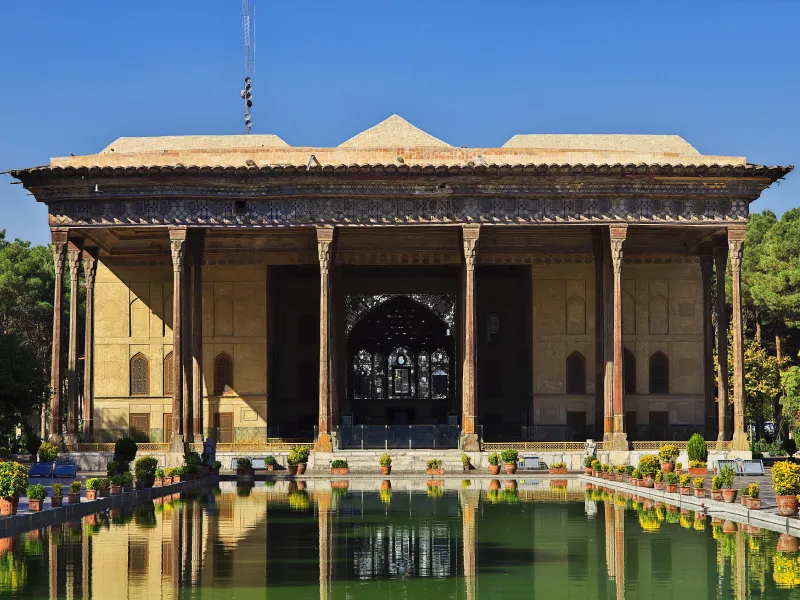
Chehel Sotoun Palace is not just a historical monument; it symbolizes the artistic and cultural achievements of the Safavid era. Its gardens, known as “Bāgh-e Chehel Sotoun,” are a serene and beautiful space that complements the architectural luxury of the palace.
Chehel Sotoun History
Chehel Sotoun Palace has a fascinating history and is a true treasure of Persian architecture. The palace was built by Shah Abbas II in the mid-17th century as part of the larger complex of Isfahan’s royal palaces. This was at the time when Isfahan was recognized as the capital city of Iran. It served as a reception hall where the Shah would entertain guests and dignitaries.
The green area of Chehel Sotoun was one of the most important of the 9 gardens of Isfahan and was actually the connecting passage between Chaharbagh and Naqsh-e Jahan square. When Shah Abbas II came to power, the simple pavilion in the garden was expanded with several halls, such as an 18-column hall, a mirror hall, and luxurious and large rooms on the first floor were made in the main building.
The new palace was ornamented with a variety of Persian decorations, including mirror work, miniature paintings, tile work, and moqran decorations, and a large pool was made on the front side of the palace. The building was later called the most blessed structure in the world.
Chehel Sotoun Architecture
Chehel Sotoun Palace is a perfect example of the best of Persian architectural traditions and innovative design. The palace’s architecture is a combination of Iranian, Chinese, and French architecture. The palace and its garden area are about 67,000 square meters.
When visiting Chehel Sotoun Palace, you will first see a large porch with a length of 38 meters and a width of 17 meters. This porch is on the eastern side of the building and has 18 wooden columns with a height of 14 meters made from trunks of plantain and pine trees, each of which is skillfully decorated. The slender wooden columns are intricately carved and support a high wooden ceiling.
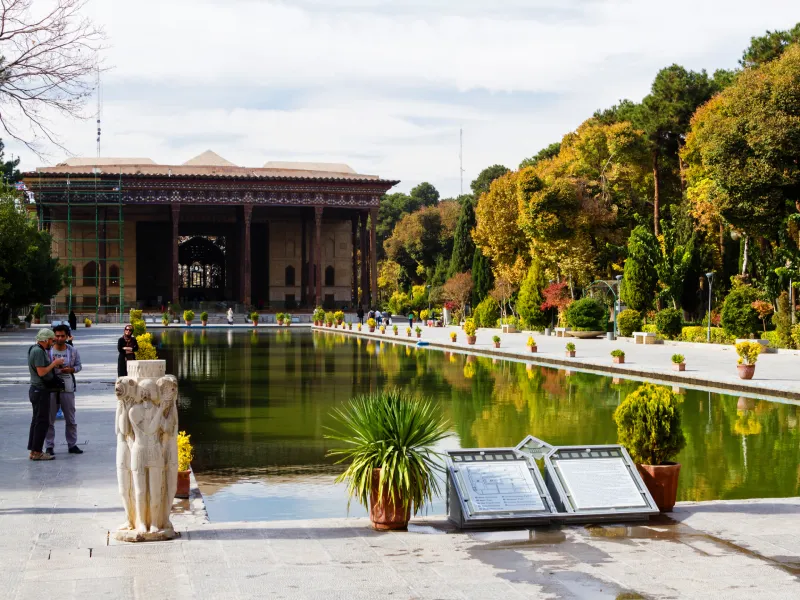
There are also four central columns and on each column are four beautifully carved stone lions. The lions’ statues are fountains that pour water into the marble pool between the four columns. The spectacular roof of the porch is made of wood and decorated with paintings and mirrors.
These gardens are designed in the traditional Persian style, with symmetrical layouts, pathways, and water channels.
The large pool in front of the palace reflects the columns and the façade, creating a picturesque view. Water features play a significant role in Persian garden design, symbolizing purity and tranquility.
Chehel Sotoun Palace Interior
The main hall is a spacious area adorned with frescoes and mirrorwork. It was used for receptions and gatherings. The walls of the palace are decorated with frescoes that depict historical events, royal ceremonies, and cultural scenes. These frescoes are known for their vivid colors and intricate details.
The interior features extensive mirror work, particularly in the main hall. Small pieces of mirror are arranged in geometric patterns to create dazzling reflections. The palace is adorned with exquisite tile work, including floral motifs and geometric patterns. The tiles are crafted with great precision and artistry.
The palace encompasses both indoor and outdoor spaces, with large windows and terraces that offer views of the gardens. The palace is surrounded by lush gardens, known as Bāgh-e Chehel Sotoun.
These gardens are designed in the traditional Persian style, with symmetrical layouts, pathways, and water channels.
The large pool in front of the palace reflects the columns and the façade, creating a picturesque view. Water features play a significant role in Persian garden design, symbolizing purity and tranquility.
Chehel Sotoun Paintings
The paintings and frescoes at Chehel Sotoun Palace are popular for their artistic excellence and historical depictions. They include vivid and rich colors, complex details, and fine hand-drawn oil paintings, all characteristic of the Safavid era.
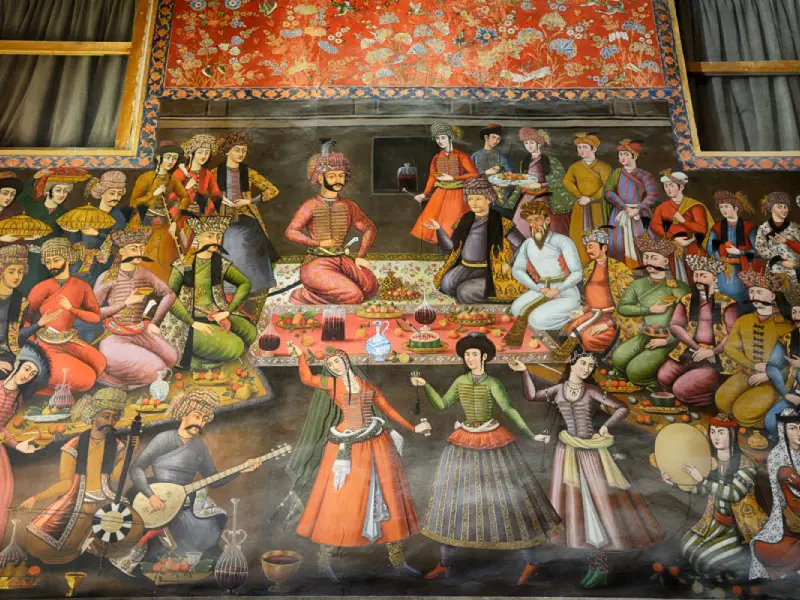
The frescoes capture important historical events such as the Battle of Chaldiran and the reception of Mughal Emperor Humayun.
Additionally, they show scenes of courtly life, love, and leisure, introducing the cultural and social aspects of the time. The use of symbolism in these artworks conveys deeper meanings related to power, divinity, and prosperity.
One of the most notable frescoes illustrates the reception of Mughal Emperor Humayun by Shah Tahmasp, emphasizing the diplomatic relations between the Safavid and Mughal empires.
Another prominent painting captures the celebration of the ancient Persian Sadeh festival. The paintings at Chehel Sotoun Palace remain a major attraction for visitors and art enthusiasts, providing valuable insights into the history and culture of the Safavid era.
Chehel Sotoun Reviews
Chehel Sotoun Palace, a UNESCO World Heritage site in Isfahan, Iran, is cherished for its distinguished architecture, colorful frescoes, and beautiful gardens.
Visitors praise the vibrant frescoes depicting historical events, the mesmerizing mirror work in the main hall, and the serene Persian gardens that surround the palace. As a popular tourist destination, it offers a glimpse into the rich cultural heritage of the Safavid era, making the palace a must-visit site in Isfahan.
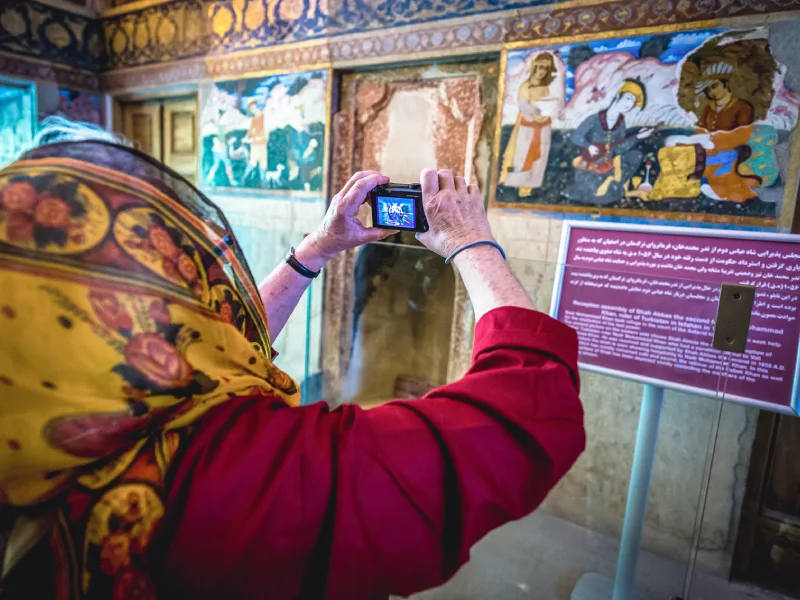
Visitor Feedback
Amina Penava: “Very nice place to see. Works of art that tell us about history. The place is really amazing, but the most beautiful part is the gardens that surround this part.”
I’m a tourist guide: “My favorite garden in Isfahan. You have to visit the Pavilion and the magnificent paintings.”
Chehel Sotoun Location
Chehel Sotoun Palace is one of the top things to do in Isfahan, Iran. Specifically, it is situated within the heart of Isfahan city, near the historic city center and not far from other famous landmarks such as Naqsh-e Jahan Square and the Ali Qapu Palace. The address is typically noted as being in Ostandari Street (Location on map).
The palace is easily accessible to visitors and is a key part of Isfahan’s rich cultural and architectural heritage.
Final Word
Chehel Sotoun Palace is a masterpiece of Persian architecture, combining artistic elegance with functional design. Its elegance captivates visitors from around the world. When you come across Chehel Sotoun photos, you will notice the artistic techniques used in these paintings, including the precise arrangement of mirror work, enhance the visual appeal and splendor of the palace.
The interior walls of the palace are adorned with magnificent frescoes, which are admired for their vibrant colors and sophisticated decorations. The tiles of Chehel Sotoun arranged in intricate geometric patterns add to the overall beauty of the palace. The combination of wood, tile, and mirror work creates a harmonious and visually stunning environment, attracting thousands of visitors every year.
Are you planning to travel to Iran and looking for an Iran resort? Consider Matinabad eco resort.

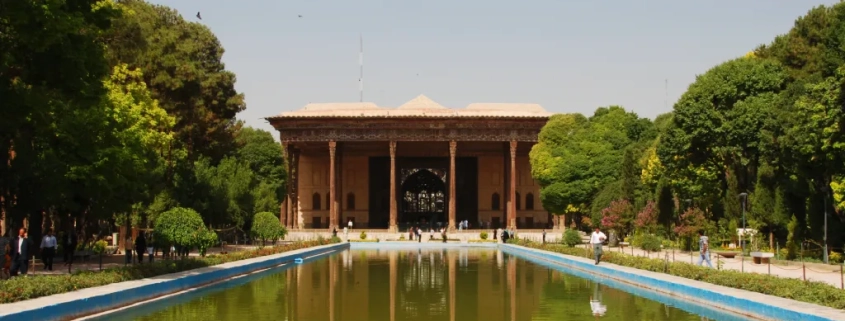



Leave a Reply
Want to join the discussion?Feel free to contribute!